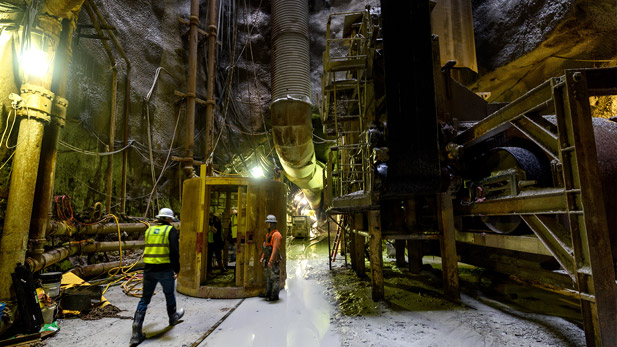Alumni Helping Indianapolis Solve Community Issues with Big Dig

Civil engineering alumni Jessica (Huggins) Bastin, Maceo Lewis and Chelsie Donnelly have been involved in several aspects of the DigIndy program, a series of deep rock tunnels which will virtually eliminate combined sewer overflows in Indianapolis.
Indianapolis residents have spent the past seven years working, living and playing in Indiana’s capital city while being mostly oblivious to a massive public works project that’s forging a 28-mile-long network of deep rock tunnels 250 feet beneath their feet.
The $2 billion DigIndy Tunnel System is a network of underground tunnels being built by Citizens Energy Group to virtually eliminate combined sewer overflows (CSO) into area waterways by 2025 – complying with a federal consent decree and state regulations to improve the quality of area waterways, while providing future economic development benefits.
Four Rose-Hulman alumni have had an active role in several aspects of the DigIndy program – one of the largest civil engineering endeavors in Indiana history. Mayor Joe Hogsett has classified DigIndy as a “transformational project for Indianapolis.”
Jeff Harrison, a 1989 electrical engineering graduate, is Citizens Energy Group’s president and chief executive officer. The public charitable trust acquired Indianapolis’ water and wastewater assets in 2011.
Meanwhile, Jessica (Huggins) Bastin, a 2001 civil engineering alumna, has supervised overall project design and implementation since 2015 as the utility’s manager of water and wastewater design, capital programs and engineering division. Maceo Lewis, another 2001 civil engineering graduate, has been a member of the project design team since 2009 as a project manager with Black & Veatch, and Chelsie Donnelly, a 2016 civil engineering alumna, joined the design team after graduation as a senior project engineer with F.A. Wilhelm Construction Inc.
A series of tunnels ranging from 1.7 miles to 7.9 miles in length that traverse below Indianapolis, will transform antiquated combined storm water and wastewater sewer systems and, with other enhancements, more than double the capacity of two advanced wastewater treatment plants in the city. The program has already prevented almost one billion gallons of sewage from overflowing into five local tributaries since the first 10-mile tunnel segment opened in December of 2017.
“DigIndy is now functioning just as it was designed,” says Harrison.
Using deep tunnel technology has reduced disturbances to neighborhoods along the project route, says Bastin. Value engineering strategies and cutting-edge deep rock boring techniques have helped reduce costs and maximize savings.
The halfway point of the mining portion of the project was completed last fall. The entire project is scheduled to conclude in 2025.
“We have worked hard to find innovative ways to keep the project ahead of schedule and under budget, while maximizing benefits for the environment,” says Bastin. “This project impacts nearly every person in the city, whether they live or work here.”
[See Bastin explain why the DigIndy project was needed to improve quality of life in Indianapolis.]
The project has required Citizens and contractors to work closely with city government officials, transportation and parks entities, and local citizens and neighborhood groups about aspects of the project. Residents are starting to see construction of the surface sewers and drop shaft sites as Citizens works to correlate work with other improvement projects throughout the city, including bridge replacements, neighborhood redevelopment projects and rapid transit system projects.
“The initial challenge was coming up with the plan. We’re consolidating about 140 overflow points throughout the city into a more manageable system,” says Lewis. “It is fascinating to see all of the technologies coming together. It may seem easy to just separate storm and wastewater sewer systems, but that’s a very disruptive and costly solution. It’s phenomenal to have something 250 feet deep that the community doesn’t even know is happening.”
[Watch Lewis talk about anticipating and reacting to problems in the DigIndy project.]
Donnelly started working on the project as a Citizens intern, where she supported efforts to secure funding for DigIndy through the Indiana Finance Authority State Revolving Fund loan program. After graduation, she has concentrated on construction of the near-surface infrastructure.
“This is an extremely valuable project because we want to keep our waterways clean and usable for recreation,” says Donnelly.
[See Donnelly talk about her involvement in the project – from intern to engineer.]
Bastin adds, “I went into civil engineering to make a difference. The most rewarding part of this project is seeing the impact we’re making for the environment.”